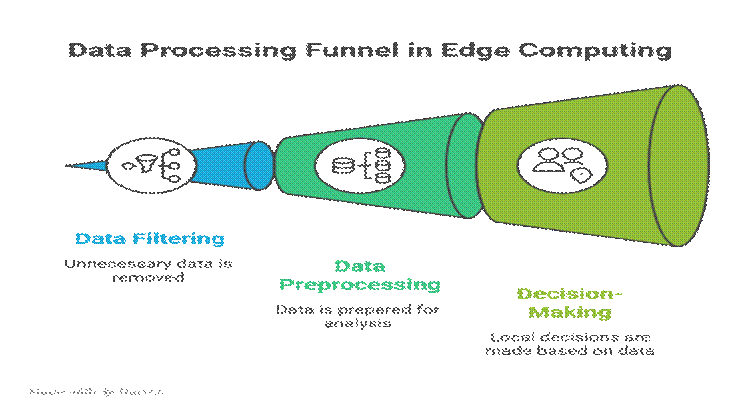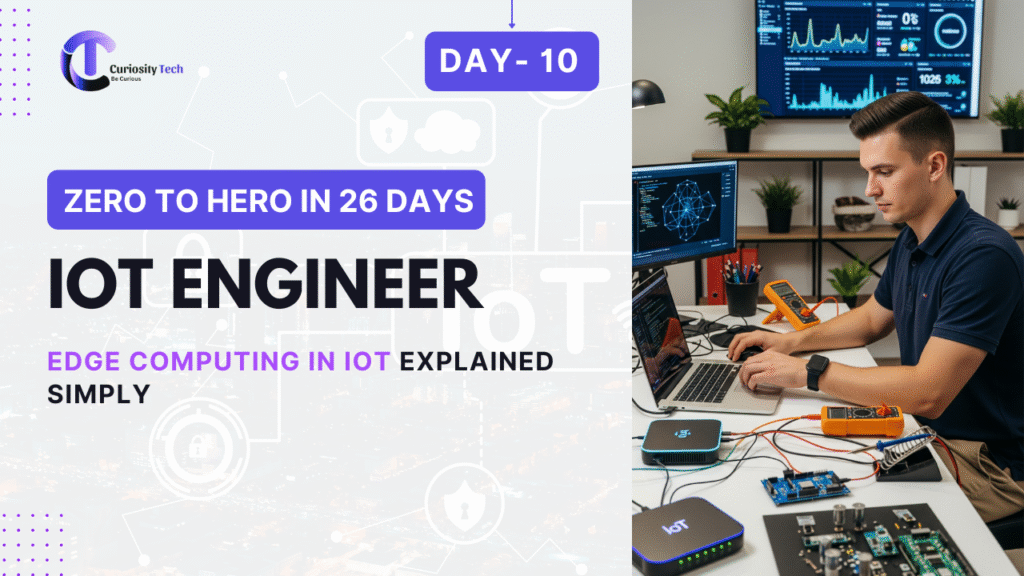The Story Analogy: From the Farmer’s Market to the Cloud
Imagine a farmer’s cooperative in Nagpur. Farmers wake up at dawn, pick vegetables, and load them onto trucks that travel 300 km to sell the produce at a central wholesale market. Now imagine if they had mini-markets in every village where data about vegetable prices and availability could be shared with traders instantly. The farmers no longer need to wait for centralized updates; decisions are made faster, with local information.
This is exactly the difference between cloud computing vs. edge computing in IoT. The “cloud” is the central city market; the “edge” is the mini-market built closer to the farmers — or in real terms, the IoT devices and gateways close to data sources.
Plain Definition
Edge computing in IoT means processing data near the source (devices/gateways) instead of sending everything to remote cloud servers.
So instead of sending all raw data to AWS/Azure/Google every second, edge computing performs some filtering, preprocessing, or even decision-making locally — reducing latency, costs, and bandwidth usage.

How Edge Fits into IoT
IoT devices → Edge Gateways/Edge Servers → Cloud → Applications
- Devices (sensors): Measure environment.
- Edge (local compute): Filters, compresses, responds quickly.
- Cloud: Stores, scales, performs heavy analytics and global reporting.
Technical Breakdown (but simplified)
Key Components at the Edge
- IoT Gateways: Raspberry Pi, Intel NUC, NVIDIA Jetson, or industrial edge servers.
- Edge Frameworks: AWS Greengrass, Azure IoT Edge, Google Edge TPU, EdgeX Foundry.
- Local Databases: SQLite, InfluxDB (storing temporary time-series).
- AI at Edge: On-device ML (TinyML, TensorFlow Lite).
Functions Performed at the Edge
- Data filtration: Remove redundant sensor data.
- Preprocessing: Convert raw data into summaries.
- Real-Time Decisions: Immediate actions like triggering an actuator.
- Offline Continuity: Systems working even without continuous internet.
Field Metaphor 2: Security Guards at the Gate
Think of a factory as a heavily guarded zone. Without edge computing, every person entering the gate would have to call head office in Mumbai to check whether they’re allowed in — wasting hours. With edge computing, a security guard at the local gate checks credentials instantly and lets trusted people in.
That’s how edge works: real-time, local validation and action.
Advantages of Edge Computing in IoT
- Low Latency: Immediate response (self-driving cars must not wait on cloud ping).
- Bandwidth savings: Only filtered/valuable data is sent to cloud.
- Improved Security: Raw data stays local; only processed insights leave the edge.
- Offline Capability: Edge nodes can run even without 24/7 internet.
- Scalability: Edge reduces cloud overload for massive IoT networks.
Real-World Scenarios
- Healthcare Monitor in Remote Villages (Nagpur use case):
- Wearable sensors detect abnormal heart rate.
- Edge gateway at local clinic runs AI model → instant alert to doctor.
- Critical data then uploaded to Azure cloud for permanent records.
- Smart Agriculture:
- Soil sensors detect critical dryness.
- Edge gateway immediately opens water valve, rather than waiting for cloud approval.
- Later, cloud receives weekly analysis of water usage.
- Industrial IoT (CuriosityTech Factory Labs):
- Machines detect vibrations.
- Edge server predicts motor failure locally → sends technician alert.
- Only event summaries sent to cloud for dashboards.
Diagram Description: Edge vs Cloud Workflow
Two pipelines:
- Traditional Cloud IoT: Device → Network → Cloud (processing & decision) → Device Action. (Longer loop, more latency).
- Edge IoT: Device → Edge Processing → Immediate Action (and then summary sent upward).
Visually, the second is a short circuit allowing quicker reactions.

Challenges of Edge Computing
- Resource Constraint: Edge devices have limited compute vs massive cloud.
- Maintenance Complexity: Thousands of distributed edge nodes need updates.
- Security Risks: Each edge must be secured individually.
- Analytical Limits: Heavy ML workloads often still require central cloud.
Case Study Research: CuriosityTech Nagpur Smart City Prototype
- Setup: IoT air quality sensors deployed in Gajanan Nagar.
- Without Edge: Sensors sending all data to cloud → delay in generating alerts.
- With Edge: Raspberry Pi gateways detected pollution spikes locally → triggered public display boards in real-time with alerts. Cloud dashboards updated later for long-term tracking.
- Result: 40% faster responses and reduced network usage by 60%.
Simplified Analogy Recap
- Cloud only: “Ask head office for every decision.”
- Edge + Cloud: “Local security guard filters, head office analyzes big trends.”
This balance is driving the IoT revolution in 2025, with AI now moving to the edge to make systems smarter and faster.
Conclusion
Edge computing is not a replacement for the cloud — it’s a partner. By making split-second local decisions, while still uploading summarized intelligence to centralized platforms, edge enables IoT systems to become agile and real-time.
From healthcare to industrial alarms, edge ensures IoT isn’t just collecting data — it’s acting on it when it matters most. That’s why CuriosityTech.in Nagpur’s IoT labs train students specifically on hybrid IoT systems, where Raspberry Pi works as an edge device integrated with cloud platforms (AWS, Azure, Google). Tomorrow’s IoT engineer will not ask whether to use edge or cloud — they’ll design systems where both seamlessly coexist.


